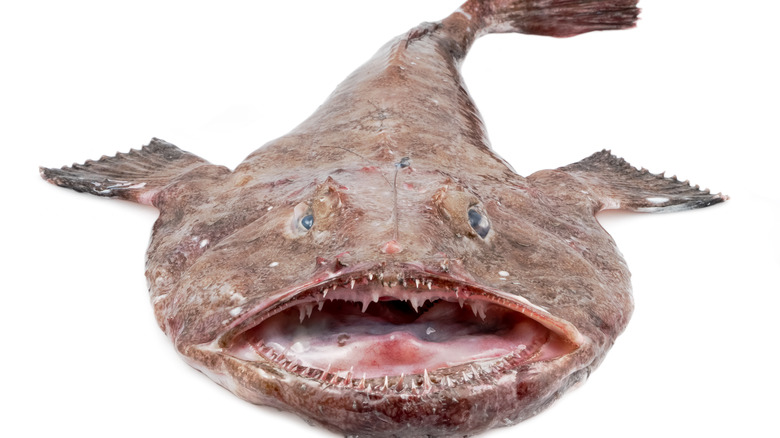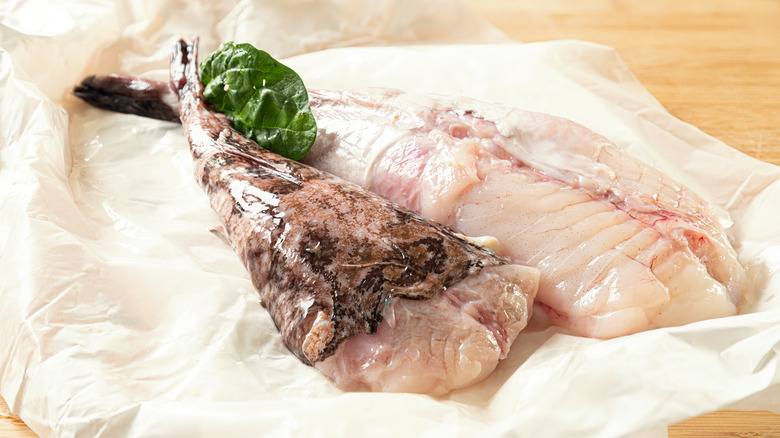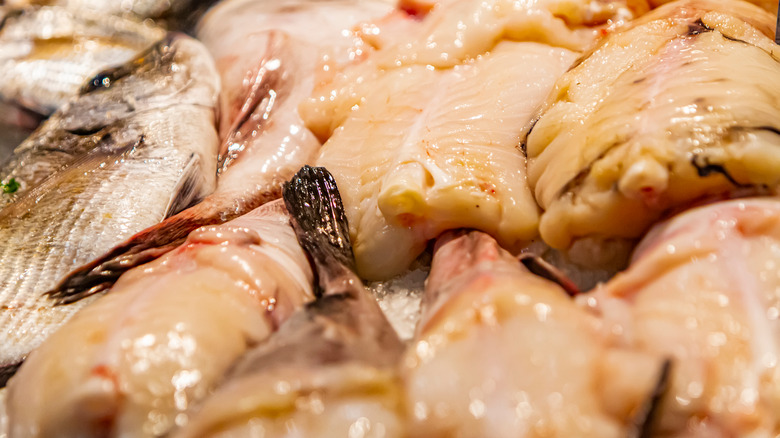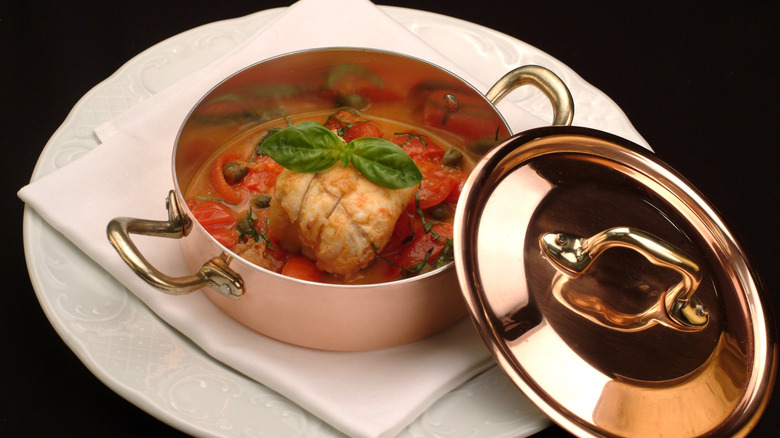What Is Monkfish And Is It Poisonous?
Because monkfish's name contains the word "monk," you might be inclined to envision this ocean-dweller as a thing of simple, peaceful beauty — a fish that quietly inhabits its world, asking for and taking little from its surroundings. No. Just no. The monkfish is, in fact, one of the most bizarre- and terrifying-looking creatures on land or sea that you're likely ever to eat. "There's only one word that would perfectly describe the monkfish," according to Just Caught UK, and that word is "ugly." With its long, dark body, its wide-gaping mouth filled with multiple rows of teeth, its arm-like fins, and its beady little close-set eyes, the monkfish looks like something out of nightmares.
But looks can be deceiving, or deceiving-ish, in this case. The monkfish happens to be a fascinating creature. It also happens to be delicious — if you're a fan of lean, bright-white fish with a mild, sweet flavor that escapes that "fishiness" taste. On the other hand, yes, there is something scary about monkfish, although it probably isn't what you think. Read on to learn what exactly is monkfish and if it is as poisonous as it is terrifying-looking.
How the monkfish got its completely misleading name
How the monkfish (scientific name: Lophius americanus) got its name is rather obscure, according to Just Caught UK. Some suggest that the name derives from the monkfish's physical resemblance to the "cowl" traditionally worn by monks. However, considering how very un-monk-like monkfish really look (if we're being honest), it's more likely that the name comes from the fact that long ago, monkfish was a preferred food among coastal monks.
And why was that? For the simple reason that fisherman who found monkfish in their nets (they never fished for monkfish intentionally back then) tended to either throw them right back into the ocean, if not throw them out entirely. Monks who lived near fishing areas back then knew something that the fishermen didn't, however, which is that notwithstanding its ugliness, this "by-caught" fish not only made for a nutritious protein-packed dinner but also tastes delicious.
Of course, the monkfish has been known at times by other names. These include "sea devils" and "frogfish" (via Global Seafoods) and "goosefish" and "allmouth" (according to one of the fishing aficionados who post at World Seafishing).
Here's what's so fascinating about monkfish
The monkfish is typically fished for in the Atlantic ocean, but it is sometimes found in the Mediterranean Sea, according to Citizen Sustainable, which points out that this bottom-dweller has "thoroughly adapted" to its surroundings by evolving to essentially "walk" along the ocean floor, rather than swimming as most fish do.
In addition, the monkfish's weird-looking fins evolved as such because they actually help the monkfish, which is a predatory beast at least as far as sea creatures are concerned, to attract its prey to its mouth (via Global Seafoods). And since the voracious monkfish is willing to eat just about anything that comes its way, according to Citizen Sustainable, it's a formidable predator for any nearby sea creature.
But the upshot is that monkfish is a perfect example of Darwinian "engineering." Well, with the exception of one thing: as ugly and off-putting as the monkfish might be, humans have figured out that the tail of the monkfish is not only edible but absolutely delicious. As a result, this fish that fishermen used to toss back into the ocean, or straight into the trash (for waiting monks to pick up and turn into dinner), has become so popular that for a time, it was deemed "overfished." Oh, the irony.
Is monkfish still considered to be overfished?
Fulton Fish Market explains that the overfishing of monkfish was caused by trying to make up for the overfishing of cod and halibut. But now the brand says, thanks to "advances in sustainable aquaculture" this is no longer a concern and "seafood lovers [can] enjoy this unique sea creature without any guilt." Well, that's a convenient opinion for a fish market to have, yes? By contrast, other opinions may differ.
For example, Citizen Sustainable points out that because of the way monkfish are caught, they are fundamentally prone to overfishing (via Citizen Sustainable). Specifically, Citizen Sustainable points out that monkfish, being bottom-dwellers, are caught using nets, and net fishing "quickly leads to overfishing and can negatively impact other species and plant life in the area."
Hook-and-line fishing is considered less problematic than net fishing, but that's simply not how monkfish are caught. Further, some might argue that no method of fishing can ever be sustainable because overfishing already has depleted fish supplies, which some forecast will be completely depleted by the year 2048. "Making responsible seafood choices is one of the most important ways that you can contribute to healthier oceans," according to Oceanic Society, and making responsible seafood choices includes selecting seafood that is considered to be "sustainable." The fact that monkfish may, in fact, be less than sustainable, is among the reasons you might wish to think twice before selecting monkfish as a protein.
What does monkfish taste like?
As basically every authority on the matter would tell you, monkfish tastes a lot like lobster, explaining why monkfish has been nicknamed "the poor man's lobster" — although growing demand for it amid potentially dwindling supply has made it somewhat more expensive than it used to be. Assuming you can find it for a reasonable price, you'll find that monkfish is one of the easier fishes to prepare. Although some people eat monkfish "cheek," it's generally the monkfish tail that you'll find available for purchase.
Monkfish tail is meaty and the only two things to really look out for while prepping are its long, single tail bone and the membrane. Once these are removed and peeled off respectively, monkfish's firm texture makes it ideal for grilling, although it can just as easily be cooked any other way you could think to cook fish (e.g., roasted, fried, poached, steamed, stewed, or made into soup).
Although your comfort levels about eating monkfish — given environmental sustainability concerns — is, of course, your business, as Tabitha Brown would say, there's one more thing to consider, and that is whether there's anything poisonous about monkfish.
Is monkfish poisonous?
There is no truth to any rumor you might have heard that monkfish is poisonous. However, at one time, the U.S. Food and Drug Administration (FDA) advised people to temporarily stop buying and eating monkfish because of a labeling snafu. Specifically, in 2007, two people in the Chicago, Illinois area were sickened after eating soup that supposedly, contained monkfish, but actually contained pufferfish, according to CBS News. Unlike monkfish, pufferfish, which is also known as fugu and is subject to restrictions in the U.S., is known to contain a potentially lethal poisonous substance known as tetrodotoxin. To put it another way, monkfish was unwittingly caught in an unfortunate net of mislabeling. But is it poisonous? No.
That said, when you eat monkfish, you might want to be aware that like many other fish that we eat, including tuna, mackerel, and seabass, it may contain mercury, which can build up in the human body, adversely affecting health, according to Verywell Fit. Nevertheless, monkfish contains only moderate levels of mercury, along the lines of what tuna, snapper, skate, and bass contain. That being said, children, as well as nursing and pregnant mothers, may wish to steer clear.





